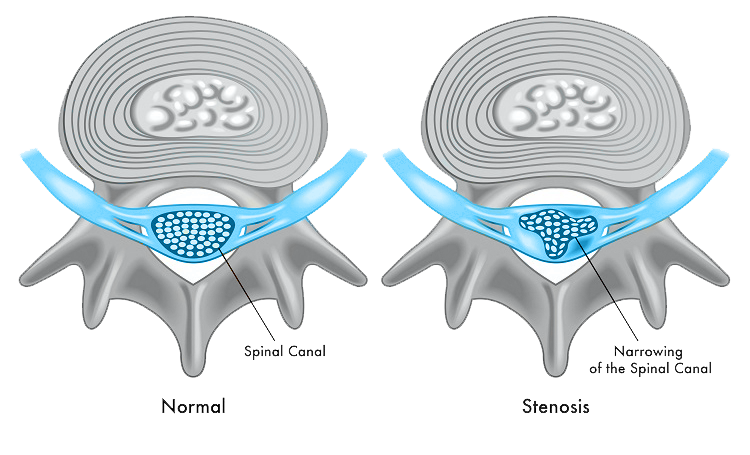What is foraminal stenosis?
The small opening on the side of the spine is called the foramen, where the nerve exits the spinal canal. Compression on the exiting nerve root can occur due to bone spurs, disc herniations, cysts, and thickened ligamentum flavum. The narrowing along the nerve can occur in one area or many areas at the same time. We describe this as compression along the top, bottom, front, and backside of the nerve. When the foramen closes, the passing nerves are pinched leading to pain, numbness, or weakness in areas of the body that the nerve serves.
Foraminal stenosis develops as you age. Arthritis, injury, and wear and tear of daily living can lead to changes in your spine that narrows the foramen. Also, injury from lifting, twisting, or accidents to your back or spine can cause stenosis as well.

Symptoms of foraminal stenosis
Not everyone with foraminal stenosis will experience symptoms and some people may have symptoms that come and go. Although you cannot prevent foraminal stenosis, staying physically active and maintaining a healthy weight can reduce your risk. The symptoms of foraminal stenosis will vary depending on which part of the spine is affected.
Cervical stenosis
Originating when the foramen of your neck the spinal nerve may cause your arm or hand to have pain, feel weak, and/or numbness when nerves become pinched. Additionally, most but not all people experience a sharp pain that begins in the neck and travels to the shoulder and down the arm.
Thoracic stenosis
When the foramen of your upper back narrows, a pinched nerve will cause pain in the back and possibly pain and numbness that wraps around the front of the body. Thoracic stenosis is the least common area to be affected by foraminal stenosis.
Lumbar stenosis
The most likely area to be affected by foraminal stenosis is the lower back. When the foramen of the lower back narrows, symptoms such as pain, tingling, numbness, and weakness in the buttock, leg, and foot can occur.
Treatments for foraminal stenosis
Depending on the cause and severity of the foraminal stenosis there are several treatment options to ease the discomfort and pain.
Physical therapy
Physical therapy may be prescribed to help build muscle strength, maintain flexibility and stability of the spine, and improve balance. With consistent physical therapy treatments, space may open in the spine for the nerve roots to pass.
Medications
Different types of medicines can be used to ease the pain. If medications are the best treatment for your situation a doctor may prescribe pain relievers, steroids, or opioids.
Epidural steroid injection
In a more targeted approach, steroids can be injected near the nerve to relieve inflammation and pain. Steroid injections typically provide temporary relief. The pain typically returns, but typically repeat injections are less helpful at resolving pain.
Surgery
If conservative treatments don’t relieve the symptoms, surgery is considered depending on the location of the stenosis and its source. A foraminotomy is a minimally invasive option that relieves pressure on the nerves by removing obstructions (e.g. bone spurs) from the foramen. But if a herniated disc is pinching the nerve root, then surgery to remove the bulging disc may be all that is needed as the solution.
